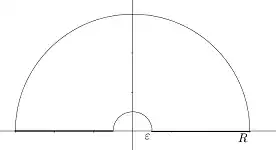Note that
$$
\int_0^\infty\frac{\sin x}xdx =
\frac 12 \int_{-\infty}^\infty\frac{\sin x}xdx =
\frac 12 \Im\left\{\int_{-\infty}^\infty\frac{e^{ix}}xdx\right\}
$$
Where $\Im$ denotes the imaginary part.
Let $\gamma_R$ be the outer semicircle, let $\gamma_I$ be the part of the contour on the real line (from right to left), and let $\gamma _\epsilon$ be the inner semicircle (clockwise). Since there are no singularities inside the contour, we have
$$
\int_{\gamma_R} + \int_{\gamma_I} + \int_{\gamma_\epsilon} = 0
$$
You should be able to argue that $\int_{\gamma_R} \to 0$, so that
$$
\lim_{R\to\infty}\lim_{\epsilon \to 0} \left(\int_{\gamma_I} + \int_{\gamma_\epsilon} \right) = 0\implies\\
\int_{-\infty}^\infty \frac{e^{ix}}{x}\,dx = \frac 12 \cdot 2 \pi i \cdot \text{Res}\left(\frac{e^{iz}}{z},z=0 \right)
$$
To compute $\text{Res}\left(\frac{e^{iz}}{z},z=0 \right)$, we take the $1/z$ coefficient of the Laurent-expansion of $e^{iz}/z$ centered at zero. The expansion is given by
$$
\frac{1}{z}\left(1 + (iz) + (iz)^2/2 + (iz)^3/6 + \cdots\right) =
\frac 1z + i - z/2 - iz^2/6 + \cdots
$$
So that $\text{Res}\left(\frac{e^{iz}}{z},z=0 \right) = 1$.
So, we conclude that
$$
\int_{-\infty}^\infty \frac{e^{ix}}{x}\,dx = \frac 12 \cdot 2 \pi i = \pi i
$$
So, taking the imaginary part and halving the result, we conclude that
$$
\int_0^\infty\frac{\sin x}xdx = \pi/2
$$
Proof that $\int_{\gamma_R} \to 0:$ In fact, this follows from Jordan's lemma
We may parameterize the integral as
$$
\int_{\gamma_R} = \int_0^\pi \frac{e^{i Re^{i\theta}}}{Re^{i\theta}} iR\,d\theta
$$
We note that
$$
\left|\int_0^\pi \frac{e^{i Re^{i\theta}}}{Re^{i\theta}} iR\,d\theta\right|
\leq
\int_0^\pi \left|\frac{e^{i Re^{i\theta}}}{Re^{i\theta}} iR\right|\,d\theta
=
\int_0^\pi \left|e^{i Re^{i\theta}}\right|\,d\theta \\
=
\int_0^\pi \left|e^{i R\cos \theta}e^{-R\sin \theta}\right|\,d\theta
=
\int_0^\pi e^{-R\sin \theta}\,d\theta
$$
The fact that this approaches $0$ as $R \to \infty$ is proven in the wikipedia link.
